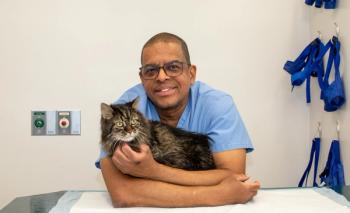
Feline geriatrics: an overview (Proceedings)
A look at the effects of aging on the body, common disorders of geriatric cats, and designing wellness programs for geriatric cats.
The Effects of Aging on the Body
Immune System
• Aging causes decline in immune function and host defense
• Chronic geriatric diseases can impair immune function
• Decreased hydration - decreased immune function
• Decreased cough reflex - pulmonary defense
Blood
• No change in basal hematopoiesis with aging
• Ability to respond to increased demand changes
• Geriatric diseases can cause anemia
• Decreased blood flow due to dehydration or underlying disease
Skin
• Decreased elastin content of skin
o assessment of hydration is difficult
• Geriatric skin is thinner
• Less effective grooming in cats
o matting
o odor
o dermatitis
• Claws can be overgrown and brittle
Neurological Changes
• Central Nervous System
o Neurochemical alterations
o Memory loss
o Decline in intelligence
• Hearing
o Cochlear hair cells decline progressively from birth
o auditory chain arthritis
o chronic ear infection
o neurological degeneration
o owners are usually unaware
The Eye
• Lenticular sclerosis
o less pronounced in cats than in dogs
• Iris
o iris ciliary muscle atrophy are common
o significant?
• Retina
o detachments occur secondary to hypertension
Oral cavity
• Dental disease is extremely common
• Decrease in olfaction occurs in aging people
• Responsible for decreased food intake in non-sick geriatric animals?
• No change in temperature, viscosity, or gustation associated with aging in human beings
• Dental disease is rarely a cause of anorexia
Cardiopulmonary
• Heart
o no change in heart rate
o increased wall thickness, decreased relaxation
o increased sternal contact on radiographs
• Lungs
o decreased elasticity and tidal volume
o decreased expiratory reserve and cough reflex
o coughing is rare in cats
o not a common cause of morbidity in aged pets
• Gastrointestinal
o Decreased gastric and intestinal mucosa turnover
o Delayed colonic transit time/increased small intestinal transit
o Decreased absorption of water,minerals, electrolytes
o Increased absorption of fat-soluble vitamins?
o Gastrointestinal diseases more severe in geriatric patients
• Urinary System
o Kidney size and function decline in most species with aging
o Impaired potassium handling
o Renal pelvis calcification in cats
o Age is a risk factor for calcium-containing urinary stones in cats
Skeleton
• Decreased proteoglycan, tensile strength and collagen content of cartilage
• Decreased chondroitin sulfate, keratin sulfate, and hyaluronic acid production
• DJD is common but may be might be less noticeablein cats than in dogs
• Radiographic findings with aging
o calcified costochondral junctions
o spondylosis
Pharmacology of Aging
• Changes in Body composition = change in Vd
• Renal clearance decreases with aging
• Hepatic clearance decreases with aging
• Clearance altered by drugs and disease
• Drugs should be used with caution
• Start at low doses
• Escalate cautiously
• Attention to drug interactions
Common Disorders of Geriatric Cats
Dental Disease
• Most common geriatric disorder
• Rarely affects ability to eat
• Significant cause of discomfort & morbidity
• Age is not a reason to withhold treatment!
• Dental radiographs should be performed
• Preventative dental care important
Chronic Renal Failure - Diagnosis
• Renal function should be monitored in all geriatric cats
• Cats with CRF can have USG of 1.035
• Hypokalemia is common
• Proteinuria precedes isosthenuria/azotemia
• Isosthenuria predisposes to UTI
• Most common cause of death of old cats
• Probably due to chronic inflammation
• Clinical signs
o Excessive drinking and urinating
o Weight loss, poor appetite
o Vomiting
o Lethargy
• Diagnosis of Chronic Renal Failure
o Urinalysis is most important
o Unable to concentrate urine
o Blood Tests
• Anemia and azotemia, sometimes electrolyte problems
o Urine Culture
• Infection of the kidney is possible
o Blood Pressure
o Ultrasound
• Chronic Renal Failure - Treatments
o Phosphorus-/protein-restricted diets
o Oral Potassium (1-2 mEq/kg/day)
o Fluid therapy
o Antihypertensive drugs
o amlodipine or enalapril
o Erythropoietin
o Phosphate binders
o H2 Blockers
• Chronic Renal Failure - Monitoring
o Dehydration
o Hypertension
o Anemia
o Hypokalemia
o Azotemia
o Proteinuria/pyuria
o Hyperphosphatemia
o Acidemia
Feline Hyperthyroidism
• Historical Findings
o Weight Loss 88%
o Hyperactivity 31%
o Polyphagia 49%
o PU/PD 36%
o Vomiting 44%
o Diarrhea 15%
o Decreased Appetite 16%
o Large fecal volume 8%
o Anorexia 7%
• Physical Findings
o Goiter 83%
o Thin 65%
o Heart murmur 54%
o Tachycardia 42%
o Gallop 15%
o Aggression 15%
o Unkempt 9%
o Thick claws 6%
• Diagnosis
o Serum TT4 is initial screening test of choice
o Some cats have "occult hyperthyroidism"
• Treatments
o Drugs, Surgery, or Radioiodine
o Is there a treatment of choice?
o Treatment causes a decline in GFR
o Caution in cats with renal disease
o Methimazole for cats with renal disease
Cancer
• Skin
o Common in dogs, not in cats
o Vaccine-associated fibrosarcoma in cats
• Mammary gland
o 50% are malignant in dogs, and 85% in cats
o Prevented by spaying at 6 – 12 months
• Mouth
o Oral Squamous Cell in cats
• Abdominal
• Lymphoma
Diabetes Mellitus
• Persistent hyperglycemia and glycosuria
• Increased risk with obesity, especially in cats
• Appetite, activity and water consumption are the best indicators of glycemic control
• Treatment of choice is insulin, although oral medications are available.
• Clinical Features
o Physical exam may be normal
o Obesity may be seen
o Weight loss may be noted
o Diabetic neuropathy
o Obesity
Designing Wellness Programs for Geriatric Cats
Client Communication is the most important aspect.
• Old age is not a disease
• Goal is to identify and treat diseases early in order to extend life and enhance quality
• Maintenance of body condition
Health Monitoring
• Monthly Checklists
o Helps clients monitor changes at home
• Frequent Office Visits
o Healthy geriatrics at least every 6 months
o Sick geriatrics more often
AAFP Vaccination Guidelines
• FVRCP every 3 years
Healthy Cats
• History and physical exam every 6 months
• Body weight and condition score every 6 months
• Annual screening tests
• Complete blood count
• Creatinine, Potassium, TT4,Urinalysis,FeLV/FIV testing if at risk
• Blood pressure measurement
Sick Cats
• History and physical exam frequently, body weight and condition score at every visit
• Screening tests (frequency determined by cat's disease and condition)
Newsletter
From exam room tips to practice management insights, get trusted veterinary news delivered straight to your inbox—subscribe to dvm360.




